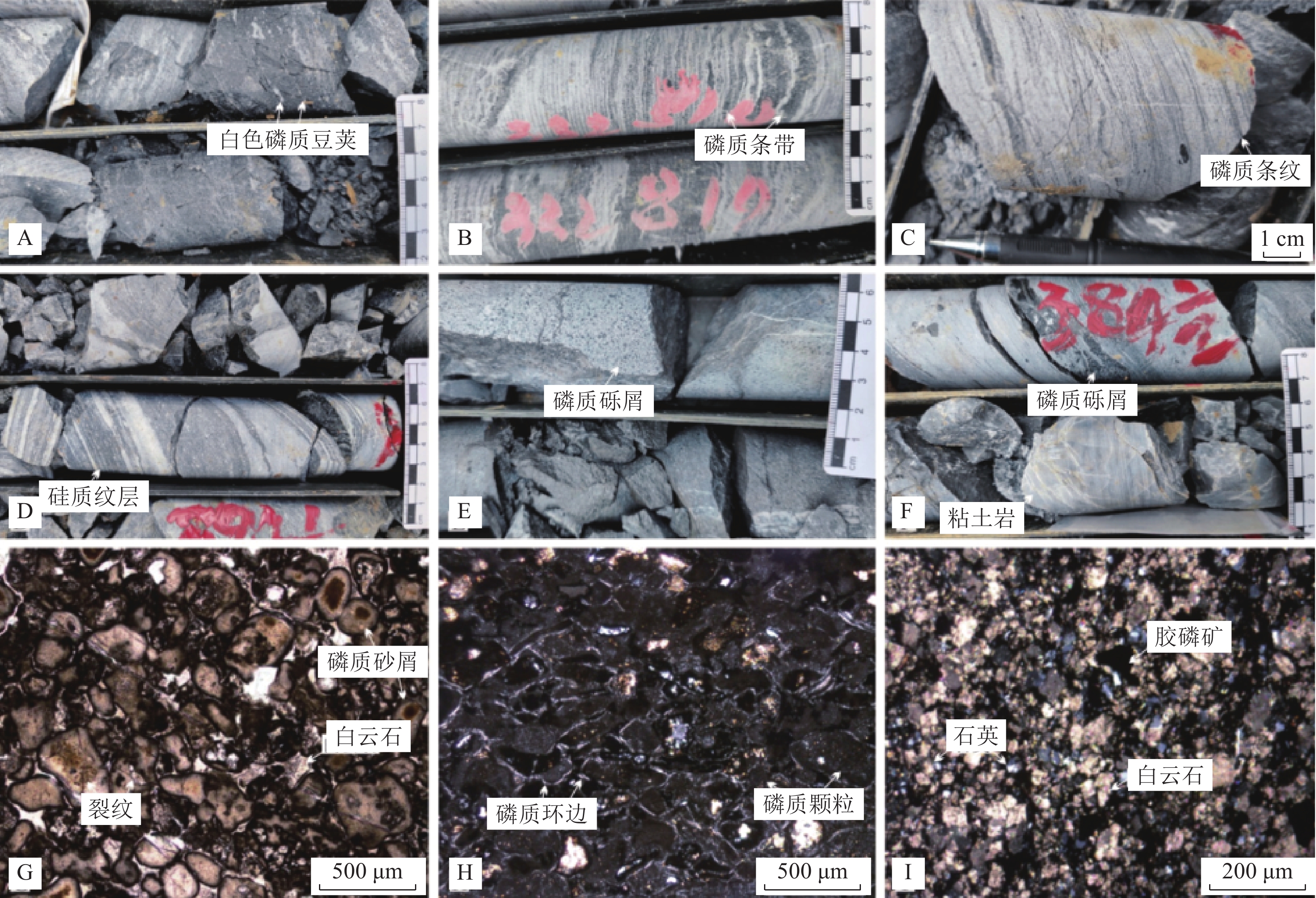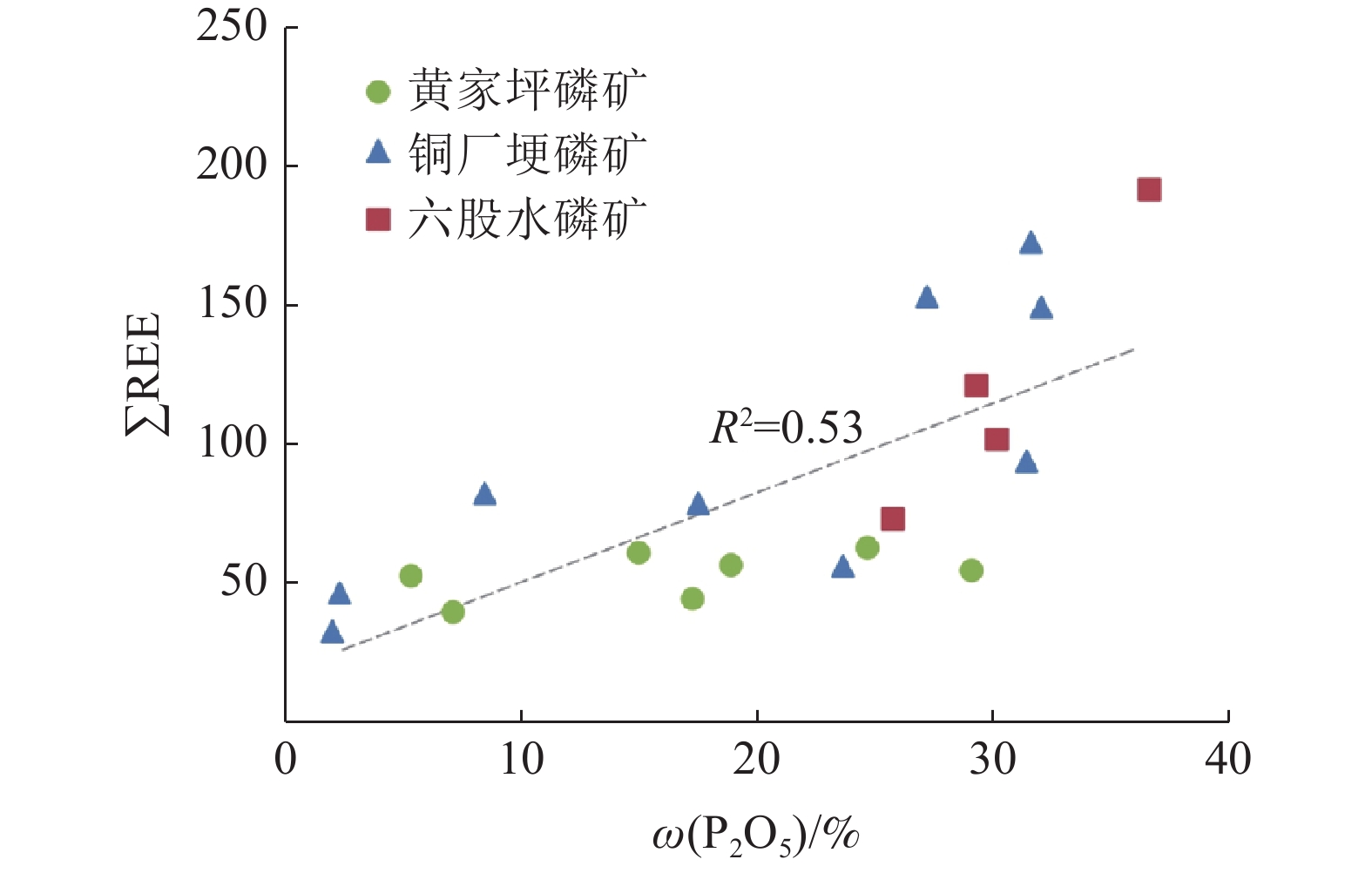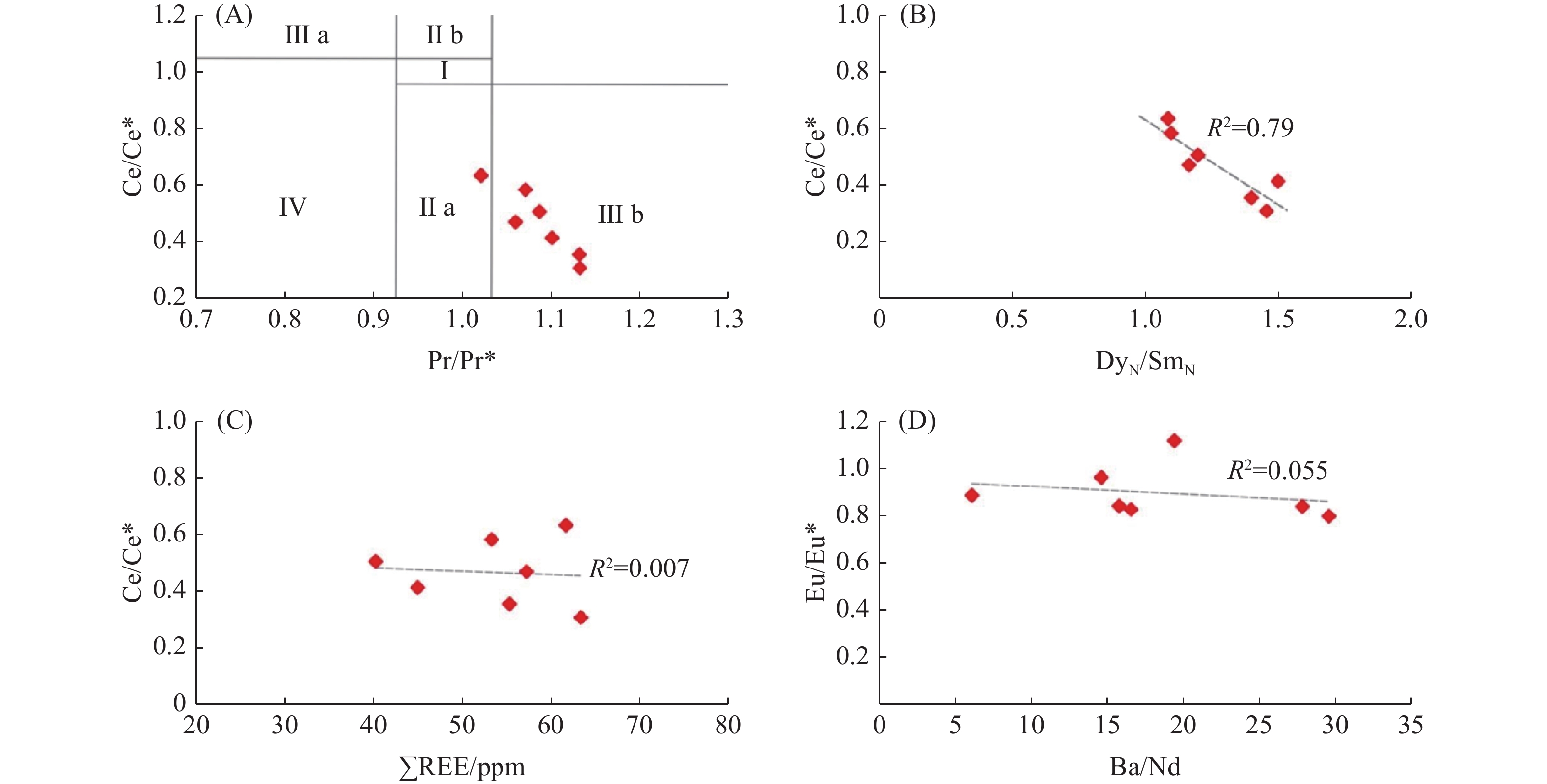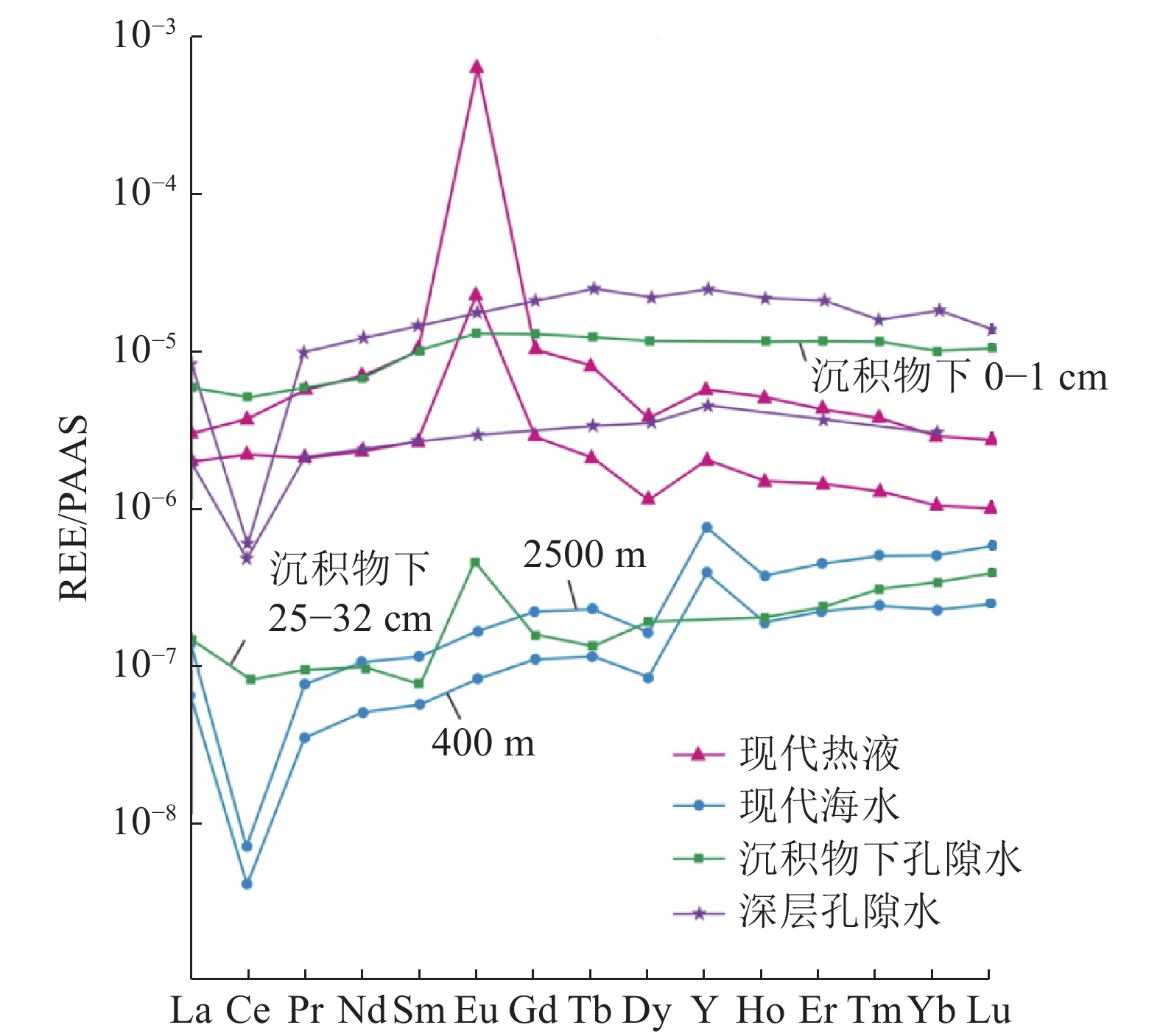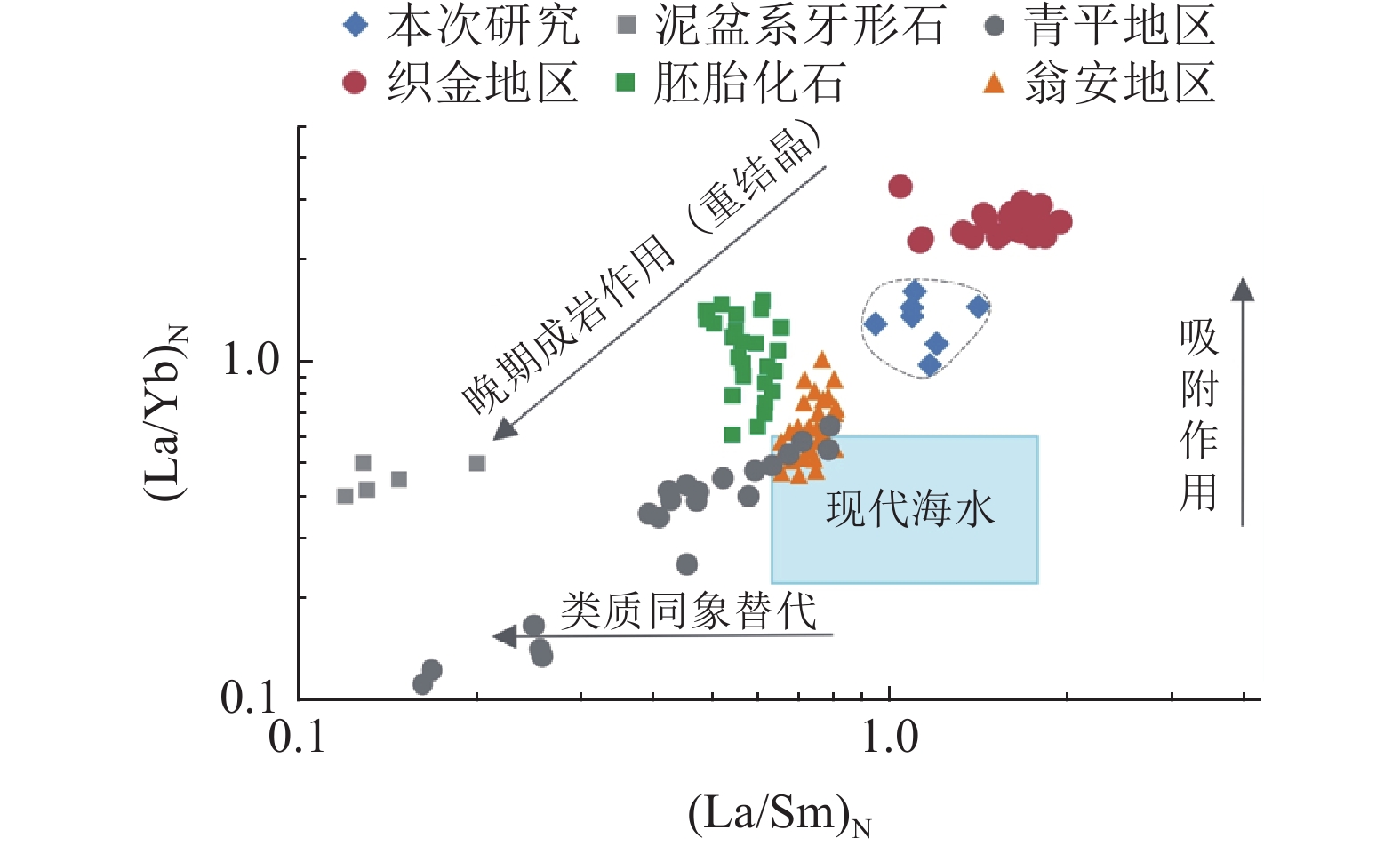Geochemical Characteristics and Formation Mechanism of Phosphorite of Lower Cambrian Maidiping Formation in Huangjiaping Area of Mabian County, Southern Sichuan
-
摘要:
早寒武世梅树村期,上扬子地台发生了大规模的成磷事件,磷块岩作为这一事件的产物,其沉积环境与成因机制尚不明确。为更好理解磷酸盐富集的沉积环境和形成机理,本文对马边黄家坪地区下寒武统麦地坪组磷块岩地球化学特征进行了研究。研究表明,磷块岩样品ΣREE与P2O5具明显正相关,(La/Yb)N和(La/Sm)N分别为0.98~1.61和0.93~1.39,均指示了REE的富集受早期成岩吸附作用影响,磷块岩较好地保留了稀土元素原始分馏特征;具有明显的Ce负异常(Ce/Ce*均值为0.44),且磷块岩内未见草莓状黄铁矿,指示其沉积于氧化/次氧化水体;Y/Ho值(均值为65)与现代含氧海水Y/Ho值一致,表明磷酸盐来源于原始氧化海水;且Eu具弱负异常(Eu/Eu*平均值0.9),指示磷块岩形成未受热水活动影响;稀土元素配分模式呈“帽子型”,指示磷块岩形成受水岩沉积界面Fe-氧化还原泵作用控制。综合上述发现,并结合早寒武世海洋存在高度分层的氧化还原结构及广泛发育上升流,磷块岩是通过铁氢氧化物氧化还原过程中释放的磷酸盐进入浅水区,并在浅埋藏过程,受生物降解作用和铁氢氧化物还原释放形成磷酸盐富集,磷酸盐和Ca2+结合形成磷灰石富集的过程。
Abstract:During the Meishucun period of the Early Cambrian, a large-scale phosphorus formation event occurred on the Upper Yangtze platform. As the product of this event, the sedimentary environment and formation mechanism of phosphorite remains elusive. In order to better understand the sedimentary environment and formation mechanism of phosphorite enrichment, we investigated the geochemical characteristics of phosphorite in Maidiping Formation of Lower Cambrian in Huangjiaping area of Mabian County. The results show that: ΣREE has significant positive correlation with P2O5, and (La/Yb)N and (La/Sm)N ratio are 0.98 ~ 1.61 and 0.93 ~ 1.39, indicating that REE enrichment is affected by early diagenetic adsorption, and the phosphorite retains the original fractionation characteristics of REE. Obvious negative Ce anomalies (average Ce/Ce* is 0.44) and the absence of framboid pyrite in the phosphorite indicating that the phosphorite were deposited under oxic/dysoxic conditions. The high Y/Ho ratio (mean 65) is consistent with the Y/Ho ratio of modern oxygen-containing seawater, indicating that phosphorite is derived from the original oxic seawater. The weak negative Eu anomaly (Eu/Eu* mean value is 0.9) indicates that the formation of phosphorite is not affected by hydrothermal activity. The REE distribution pattern is “hat type”, indicating that the formation of phosphorite is controlled by Fe-redox pump at sea-sediment interface. In combination with the above findings and combined with the highly stratified redox ocean structure and the intensive upwelling in the early Cambrian, the phosphate released during the redox of FeOOH was transported into the shallow water. In the shallow underground burial, phosphate is enriched by biodegradation and reductive release of FeOOH, and finally phosphate and Ca2+ are combined to form apatite, which is continuously enriched and ore-forming.
-
Key words:
- Phosphorite /
- Rare earth element /
- Redox environment /
- Maidiping formation
-

-
表 1 马边黄家坪地区磷块岩及围岩主量(%)、微量和稀土元素(×10-6)分析结果
Table 1. Analysis results of major (%), trace and rare earth elements (×10-6) of phosphorite and surrounding rocks in Huangjiaping area of Mabian County
样品编号 ZK1-1 ZK1-2 ZK1-3 ZK1-4 ZK1-5 ZK2-1 ZK2-2 ZK2-3 ZK2-4 ZK2-5 岩性 磷块岩 磷块岩 水云母粘土岩 磷块岩 磷块岩 含磷砂屑白云岩 磷块岩 磷块岩 磷块岩 含磷砂屑白云岩 P2O5 18.87 16.06 4.33 29.03 24.63 5.37 14.97 16.28 17.25 7.15 SiO2 4.22 26.36 49.40 7.17 5.05 12.03 12.84 21.45 11.13 8.41 TiO2 0.01 0.07 0.18 0.02 0.02 0.04 0.07 0.08 0.02 0.02 TFe2O3 0.22 0.57 1.70 0.20 0.17 0.47 1.56 1.28 0.19 0.37 MnO 0.09 0.06 0.01 0.04 0.05 0.17 0.10 0.05 0.05 0.07 Al2O3 0.12 4.21 18.42 0.97 0.27 1.10 1.49 8.78 0.88 0.67 MgO 11.39 6.64 4.12 5.49 7.90 16.20 10.53 7.10 10.76 16.60 CaO 38.63 29.15 6.76 43.04 41.94 29.14 33.63 28.16 36.21 31.07 Na2O 0.06 0.12 0.46 0.10 0.07 0.08 0.29 0.50 0.12 0.09 K2O 0.08 2.04 7.79 0.26 0.13 0.50 0.52 3.31 0.32 0.29 TFe2O3 0.22 0.57 1.70 0.20 0.17 0.47 1.56 1.28 0.19 0.37 F 1.22 1.36 1.36 2.31 2.04 0.43 1.14 1.68 1.30 0.57 Cl 0.02 0.02 0.01 0.01 0.01 0.03 0.02 0.02 0.02 0.03 LOI 26.54 16.51 3.58 14.92 20.09 35.64 25.13 13.39 24.70 36.45 V 3.14 10.50 14.40 10.10 11.90 6.48 15.10 16.20 19.30 22.70 Cr 9.94 17.70 17.30 17.30 23.60 13.30 13.20 20.20 26.30 25.20 Co 1.03 2.19 3.99 1.07 0.75 1.69 2.64 1.78 1.57 1.67 Ni 4.00 11.00 24.60 3.40 3.32 7.26 10.20 25.40 4.85 3.41 Cu 2.15 6.82 16.10 3.36 2.32 4.12 5.94 8.94 2.45 3.14 Zn 4.06 10.50 7.49 10.60 3.32 42.10 18.70 61.90 4.94 61.80 Rb 1.67 24.50 116.00 3.55 1.65 8.89 12.20 52.00 5.87 7.14 Sr 325.0 370.0 149.00 711.0 615.0 116.00 319.0 376.0 442.0 189.00 Zr 6.08 52.60 221.00 13.70 7.68 26.50 24.90 116.0 16.60 13.20 Ba 72.70 203.0 371.00 314.0 243.0 181.00 182.0 629.0 266.0 120.00 Pb 4.74 13.90 36.90 7.86 5.48 74.70 79.50 26.30 5.89 12.60 Th 0.56 6.78 46.20 3.59 0.83 1.54 1.79 18.30 3.40 1.20 U 5.31 7.57 3.74 14.10 14.70 2.91 6.00 9.15 10.50 2.88 La 17.00 32.30 34.90 17.70 22.40 13.90 16.90 44.50 13.50 11.50 Ce 14.90 51.70 74.10 11.40 11.90 16.00 19.80 73.80 10.30 11.00 Pr 2.49 6.18 8.01 2.38 2.59 2.47 2.65 8.19 1.92 1.82 Nd 11.70 25.20 33.00 11.30 12.50 10.90 11.50 33.50 9.01 8.18 Sm 2.27 5.15 7.46 2.17 2.34 2.16 2.28 7.11 1.70 1.55 Eu 0.47 0.60 0.41 0.44 0.66 0.39 0.43 0.74 0.34 0.35 Gd 2.66 5.28 7.23 2.70 3.11 2.28 2.46 7.05 2.20 1.80 Tb 0.37 0.80 1.19 0.37 0.41 0.33 0.34 1.11 0.32 0.26 Dy 2.22 4.99 7.88 2.55 2.86 1.99 2.08 7.06 2.14 1.56 Y 28.70 50.60 60.40 44.70 50.20 20.70 24.10 64.70 33.50 18.30 Ho 0.48 1.04 1.66 0.62 0.68 0.41 0.45 1.51 0.50 0.32 Er 1.34 3.20 5.46 1.88 2.02 1.16 1.29 4.63 1.52 0.94 Tm 0.15 0.41 0.84 0.21 0.23 0.14 0.15 0.64 0.19 0.11 Yb 0.78 2.44 5.73 1.16 1.14 0.80 0.87 4.08 1.02 0.63 Lu 0.09 0.31 0.80 0.15 0.14 0.10 0.11 0.53 0.13 0.08 ∑REE+Y 85.62 190.20 249.06 99.72 113.17 73.73 85.40 259.15 78.29 58.40 Y/Ho 59.67 48.65 36.39 72.56 74.26 50.61 53.67 42.85 66.47 56.66 Ce/Ce* 0.47 0.82 0.99 0.36 0.31 0.59 0.64 0.86 0.42 0.51 Eu/Eu* 0.89 0.54 0.26 0.84 1.12 0.83 0.84 0.49 0.80 0.96 Y/Y* 2.22 1.77 1.33 2.84 2.88 1.83 1.99 1.58 2.57 2.06 Pr/Pr* 1.06 1.00 0.95 1.13 1.13 1.07 1.02 0.97 1.10 1.09 LaN/SmN 1.09 0.91 0.68 1.19 1.39 0.93 1.08 0.91 1.15 1.08 DyN/SmN 1.16 1.15 1.25 1.39 1.45 1.09 1.08 1.18 1.49 1.19 Ba/Nd 6.21 8.06 11.24 27.79 19.44 16.61 15.83 18.78 29.52 14.67 Ba/Sm 32.03 39.42 49.73 144.70 103.85 83.80 79.82 88.47 156.47 77.42 -
[1] 韩豫川, 夏学惠, 肖荣阁, 等. 中国磷块岩[M]. 北京: 地质出版社, 2012: 1-649.
HAN Y C, XIA X H, XIAO R G, et al. Phosphate rock in China[M]. Beijing: Geology Press, 2012, 1-649.
[2] 张君, 张玙, 杨豫川. 四川雷波矿集区磷矿沉积特征及成矿规律研究[J]. 沉积与特提斯地质, 2018, 38(4):76-84. ZHANG J, ZHANG Y, YANG Y C. Sedimentary characteristics and mineralization of phosphorite deposits in Leibo ore field, Sichuan[J]. Sedimentary Geology and Tethyan Geology, 2018, 38(4):76-84. doi: 10.3969/j.issn.1009-3850.2018.04.008
[3] 曾允孚, 沈丽娟, 何廷贵, 等. 滇东早寒武世含磷岩系层序地层分析[J]. 矿物岩石, 1994, 14(3):43-53. ZENG Y F, SHEN L J, HE T G, et al. Preliminary analysis of the outcrop sequence stratigraphy for phosphatic series of Early Cambrian in eastern Yunnan[J]. Journal of Mineralogy and Petrology, 1994, 14(3):43-53. doi: 10.19719/j.cnki.1001-6872.1994.03.005
[4] Sato T, Isozaki Y, Hitachi T, et al. A unique condition for early diversification of small shelly fossils in the lowermost Cambrian in Chengjiang, South China: Enrichment of phosphorus in restricted embayments[J]. Gondwana Research, 2014, 25(3):1139-1152. doi: 10.1016/j.gr.2013.07.010
[5] Zhang Z Y, Jiang Y H, Niu H C, et al. Enrichment of rare earth elements in the early Cambrian Zhijin phosphorite deposit, SW China: Evidence from francolite micro-petrography and geochemistry[J]. Ore Geology Reviews, 2021, 138:104342. doi: 10.1016/j.oregeorev.2021.104342
[6] Yang H Y, Xiao J F, Xia Y, et al. Phosphorite generative processes around the Precambrian-Cambrian boundary in South China: An integrated study of Mo and phosphate O isotopic compositions[J]. Geoscience Frontiers, 2021, 12(5):243-269.
[7] 杨兵, 金承胜, 刘欣, 等. 云南昆明寒武纪早期浅水相磷块岩的氧化还原环境及成因机制[J]. 地质学报, 2021, 95(12):3858-3868. YANG B, JIN C S, LIU X, et al. Redox environment and formation mechanism of phosphorite in the early Cambrian shallow shelf, South China[J]. Acta Geologica Sinica, 2021, 95(12):3858-3868. doi: 10.3969/j.issn.0001-5717.2021.12.020
[8] Liu Ze-Rui R, Zhou M F. Meishucun phosphorite succession (SW China) records redox changes of the early Cambrian ocean[J]. Geological Society of America Bulletin, 2017, 129(11-12):1554-1567.
[9] 肖朝益, 张正伟, 何承真, 等. 华南埃迪卡拉纪磷矿的沉积环境[J]. 矿物岩石地球化学通报, 2018, 37(1):121-138. XIAO C Y, ZHANG Z W, HE C Z, et al. The depositional environment of Ediacaran phosphorite deposits, South China[J]. Bulletin of Mineralogy, Petrology and Geochemistry, 2018, 37(1):121-138. doi: 10.19658/j.issn.1007-2802.2018.37.007
[10] 张玙, 程文斌, 杨豫川, 等. 四川马边铜厂埂磷矿床稀土元素地球化学特征[J]. 矿物岩石, 2020, 40(1):50-59. ZHANG Y, CHENG W B, YANG Y C, et al. REE geochemical characteristics of Tongchanggeng phosphate deposit in Mabian county, Sichuan province[J]. Mineralogy and Petrology, 2020, 40(1):50-59. doi: 10.19719/j.cnki.1001-6872.2020.01.06
[11] Yang H Y, Zhao Z F, Xia Y, et al. REY enrichment mechanisms in the early Cambrian phosphorite from South China[J]. Sedimentary Geology, 2021, 426:106041. doi: 10.1016/j.sedgeo.2021.106041
[12] Chen J Y, Yang R D, Wei H R, et al. Rare earth element geochemistry of Cambrian phosphorites from the Yangtze Region[J]. Journal of Rare Earths, 2013, 31:101-112. doi: 10.1016/S1002-0721(12)60242-7
[13] Yang H Y, Xiao J F, Xia Y, et al. Diagenesis of Ediacaran-early Cambrian phosphorite: comparisons with recent phosphate sediments based on LA-ICP-MS and EMPA[J]. Ore Geology Reviews, 2022:104813.
[14] Zhang H J, Fan H F, Wen H J, et al. Controls of discrepant REY enrichment in the early Cambrian phosphorites[J]. Geochimica et Cosmochimica Acta, 2022, 324:117-139. doi: 10.1016/j.gca.2022.03.003
[15] Wang J, Li Z X. History of Neoproterozoic rift basins in South China: implications for Rodinia break-up[J]. Precambrian Research, 2003, 122(1):141-158.
[16] 刘建清, 何利, 江永富, 等. 四川雷波地区下寒武统麦地坪含磷地层研究及磷矿资源潜力分析[J/OL]. 中国地质, 2020, 1-17. http://kns.cnki.net/kcms/detail/11.1167.P.20200804.0937.004.html.
LIU J Q, HE L, JIANG Y F, et al. Phosphorus bearing strata in Maidiping Formation of Lower Cambrian in Leibo area of Sichuan province and its potential analysis of phosphate resources[J/OL]. Geology in China, 2020, 1-17. https://kns.cnki.net/kcms/detail/11.1167.P.20200804.0937.004.html.
[17] 李皎, 何登发. 四川盆地及邻区寒武纪古地理与构造—沉积环境演化[J]. 古地理学报, 2014, 16(4):441-460. LI J, HE D F. Palaeogeography and tectonic-depositional environment evolution of the Cambrian in Sichuan Basin and adjacent areas[J]. Journal of Palaeogeography, 2014, 16(4):441-460. doi: 10.7605/gdlxb.2014.04.037
[18] 牟传龙, 梁薇, 周恳恳, 等. 中上扬子地区早寒武世(纽芬兰世—第二世)岩相古地理[J]. 沉积与特提斯地质, 2012, 32(3):41-53. MOU C L, LIANG W, ZHOU K K, et al. Sedimentary facies and palaeogeography of the middle-upper Yangtze area during the Early Cambrian (Terreneuvian-Series 2)[J]. Sedimentary Geology and Tethyan Geology, 2012, 32(3):41-53. doi: 10.3969/j.issn.1009-3850.2012.03.004
[19] 张芹贵, 彭向辉, 祝建华. 马边-雷波峨边-金阳大断裂构造特征及活动性[J]. 四川地质学报, 2019, 39(1):30-33. ZHANG Q G, PENG X H, ZHU J H. Characteristics and activity of the Mabian-Leibo-Ebian-Jinyang major fault[J]. Acta Geologica Sichuan, 2019, 39(1):30-33. doi: 10.3969/j.issn.1006-0995.2019.01.007
[20] Qi L, Hu, J, Gregoire D C. Determination of trace elements in granites by inductively coupled plasma mass spectrometry[J]. Talanta, 2000, 51(3):507-513. doi: 10.1016/S0039-9140(99)00318-5
[21] Bau M, Dulski P. Distribution of yttrium and rare-earth elements in the Penge and Kuruman iron-formations, Transvaal Supergroup, South Africa[J]. Precambrian Research, 1996, 79:37-55. doi: 10.1016/0301-9268(95)00087-9
[22] McLennan S M. Rare earth elements in sedimentary rocks: influence of provenance and sedimentary processes[J]. Reviews in Mineralogy and Geochemistry, 1989, 21(8):169-200.
[23] 刘力生. 四川省马边县六股水磷矿床的地质特征[J]. 化工矿产地质, 2010, 32(4):201-205. LIU L S. Geological characters of liugushui phosphorus deposit of Mabian city, Sichuan province[J]. Geology of Chemical Minerals, 2010, 32(4):201-205. doi: 10.3969/j.issn.1006-5296.2010.04.002
[24] Pi D H, Liu C Q, Shields-Zhou G A, et al. Trace and rare earth element geochemistry of black shale and kerogen in the early Cambrian Niutitang Formation in Guizhou Province, South China: Constraints for redox environments and origin of metal enrichments[J]. Precambrian Research, 2013, 225:218-229. doi: 10.1016/j.precamres.2011.07.004
[25] Shields G A, Stille P. Diagenetic constraints on the use of cerium anomalies as palaeoseawater redox proxies: an isotopic and REE study of Cambrian phosphorites[J]. Chemical Geology, 2001, 175:29-48. doi: 10.1016/S0009-2541(00)00362-4
[26] Zhu B, Jiang S Y, Yang J H, et al. Rare earth element and Sr-Nd isotope geochemistry of phosphate nodules from the lower Cambrian Niutitang Formation, NW Hunan Province, South China[J]. Palaeogeography, Palaeoclimatology, Palaeoecology, 2014, 398:132-143. doi: 10.1016/j.palaeo.2013.10.002
[27] Bau M, Schmidt K, Koschinsky A, et al. Discriminating between different genetic types of marine ferromanganese crusts and nodules based on rare earth elements and yttrium[J]. Chemical Geology, 2014, 381:1-9. doi: 10.1016/j.chemgeo.2014.05.004
[28] Pack A, Russell S S, Shelley J M G, et al. Geo- and cosmochemistry of the twin elements yttrium and holmium[J]. Geochimica et Cosmochimica Acta, 2007, 71:4592-4608. doi: 10.1016/j.gca.2007.07.010
[29] Nozaki Y, Zhang J, Amakawa H. The fractionation between Y and Ho in the marine environment[J]. Earth and Planetary Science Letters, 1997, 148:329-340. doi: 10.1016/S0012-821X(97)00034-4
[30] Bau M, Mller P, Dulski P. Yttrium and lanthanides in eastern Mediterranean seawater and their fractionation during redox-cycling[J]. Marine Chemistry, 1997, 56(1-2):123-131. doi: 10.1016/S0304-4203(96)00091-6
[31] Joosu L, Lepland A, Kirsimae K, et al. The REE-composition and petrography of apatite in 2 Ga Zaonega Formation, Russia: the environmental setting for phosphogenesis[J]. Chemical Geology, 2015, 395:88-107. doi: 10.1016/j.chemgeo.2014.11.013
[32] Bau M, Dulski P. Comparing yttrium and rare earths in hydrothermal fluids from the Mid-Atlantic Ridge: implications for Y and REE behaviour during near-vent mixing and for the Y/Ho ratio of Proterozoic seawater[J]. Chemical Geology, 1999, 155(1-2):70-90.
[33] Alibo D S, Nozaki Y. Rare earth elements in seawater: Particle association, shale normalization, and Ce oxidation[J]. Geochimica et cosmochimica acta, 1999, 63(3-4):363-372. doi: 10.1016/S0016-7037(98)00279-8
[34] Deng Y, Ren J, Guo Q, et al. Rare earth element geochemistry characteristics of seawater and porewater from deep sea in western Pacific[J]. Scientific Reports, 2017, 7(1):1-13. doi: 10.1038/s41598-016-0028-x
[35] Paul S A L, Volz J B, Bau M, et al. Calcium phosphate control of REY patterns of siliceous-ooze-rich deep-sea sediments from the central equatorial Pacific[J]. Geochimica et Cosmochimica Acta, 2019, 251:56-72. doi: 10.1016/j.gca.2019.02.019
[36] Gao P, He Z L, Li S J, et al. Volcanic and hydrothermal activities recorded in phosphate nodules from the Lower Cambrian Niutitang Formation black shales in South China[J]. Palaeogeography, Palaeoclimatology, Palaeoecology, 2018, 505:381-397. doi: 10.1016/j.palaeo.2018.06.019
[37] 常晓琳, 黄元耕, 陈中强, 等. 沉积地层中草莓状黄铁矿分析方法及其在古海洋学上的应用[J]. 沉积学报, 2020, 38(1):150-165. CHANG X L, HUANG Y G, CHEN Z Q, et al. The microscopic analysis of pyrite framboids and application in paleo-oceanography[J]. Acta Sedimentologica Sinica, 2020, 38(1):150-165. doi: 10.14027/j.issn.1000-0550.2019.099
[38] 何艳丽, 张君, 游学军. 四川马边老河坝矿区铜厂埂矿段八号矿块磷矿矿石物质组分特征[J]. 四川地质学报, 2015, 35(3):407-411. HE Y L, ZHANG J, YOU X J. Ore Material components of the 8th phosphorite deposit in Mabian, Sichuan[J]. Acta Geologica Sichuan, 2015, 35(3):407-411. doi: 10.3969/j.issn.1006-0995.2015.03.022
[39] Reynard B, Lécuyer C, Grandjean P. Crystal-chemical controls on rare-earth element concentrations in fossil biogenic apatites and implications for paleoenvironmental reconstructions[J]. Chemical Geology, 1999, 155(3-4):233-241. doi: 10.1016/S0009-2541(98)00169-7
[40] Feng L J, Li C, Huang J, et al. A sulfate control on marine mid-depth euxinia on the early Cambrian (ca. 529-521 Ma) Yangtze platform, South China[J]. Precambrian Research, 2014, 246:123-133. doi: 10.1016/j.precamres.2014.03.002
[41] Cui H, Xiao S H, Zhou C M, et al. Phosphogenesis associated with the Shuram Excursion: Petrographic and geochemical observations from the Ediacaran Doushantuo Formation of South China[J]. Sedimentary Geology, 2016, 341:134-146. doi: 10.1016/j.sedgeo.2016.05.008
[42] Jin C S, Li C, Algeo T J, et al. Controls on organic matter accumulation on the early-Cambrian western Yangtze Platform, South China[J]. Marine and Petroleum Geology, 2020, 111:75-87. doi: 10.1016/j.marpetgeo.2019.08.005
[43] Sinha S, Muscente A D, Schiffbauer J D, et al. Global controls on phosphatization of fossils during the Toarcian oceanic anoxic event[J]. Scientific reports, 2021, 11(1):1-13. doi: 10.1038/s41598-020-79139-8
-




 下载:
下载:
